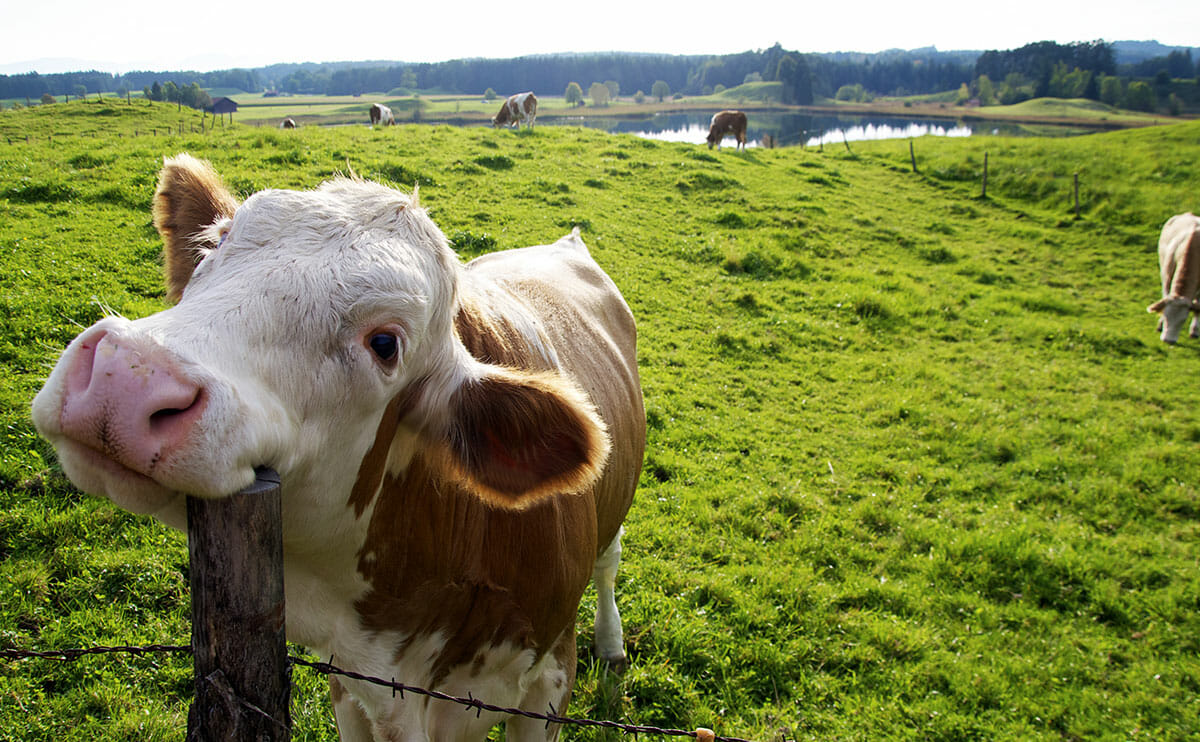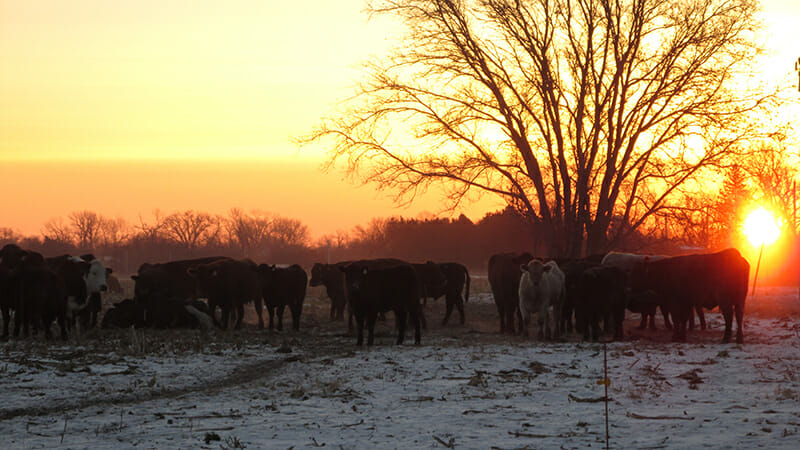Turnips for Cows
Cows’ new favorite: turnips.

In the summer this is a seed-corn field, but in winter months, it’s not just corn stubble. Intermixed are bright green — albeit frosty and slightly wilted — plants.
“We do a mix of turnips, tillage radishes and Ethiopian cabbage,” Cast explains.
Turnips, radishes and cover crops in general aren’t necessarily a new phenomenon, but they are gaining a renewed popularity. As Cast explains, there has been a real push from universities and the U.S. Cooperative Extension ”“ a branch of the U.S. Department of Agriculture (USDA) ”“ to work on soil conservation.

This is something at which radishes and turnips excel. The large tubers break up soil compaction, the leafy tops give protection from snow and wind erosion and left-over biomass after grazing provides much-needed organic matter to the soil.
“We would do this even if we didn’t have the cows,” says Cast. “You can’t dig a hole anywhere on this field without turning up earthworms.”
Bruce Anderson, a professor of agronomy and extension forage specialist for the University of Nebraska-Lincoln, is also a proponent of grazing turnips and radishes.
“You do not want to be standing behind a cow that’s been grazing turnips when it coughs.”
“They have excellent feed value and forage quality,” says Anderson.
According to Anderson, producers usually see one and a half to two pounds per day in weight gain ”“ Cast’s gains have been closer to three pounds per day. This makes turnips an excellent addition to grassfed operations where producers want to avoid grains.
It should be noted — these are not small, salad-sized tubers. These are gigantic turnips the size of cantaloupe and radishes, well over a foot in length.
“You’ll see the cows out there with their heads in the air, gnawing on these giant roots,” says Cast.
The cows will select for the green aboveground bits first, then use their noses or hooves to work the bulbs out of the ground. Then, in slobbery glory, they chew on the roots, even in the cold when the bulbs are frozen. They’re like giant, turnip-flavored popsicles.
“We worried about them choking at first,” Cast says, “but it hasn’t been a problem so far.”
Anderson agrees this could be a problem; however, it takes a very specific size and shape for the cows to choke on. Another problem:
“Turnips are very diarrhetic,” Anderson says. “You do not want to be standing behind a cow that’s been grazing turnips when it coughs.”
David Cast measures the depth of a hole left by a tillage radish among dried corn stalks in his pasture.
Tillage radishes can grow up to 3 feet long leaving behind large holes that aid in aerating the soil and reducing soil compaction.
An easy fix is to plant a mix of turnips with something high in fiber for roughage; an added bonus of the added fiber is that cows can more effectively use the nutrients in the turnips and radishes.
As for their current limited use, Anderson explains that many farmers are apprehensive because turnips and radishes don’t fit well into the traditional cropping system. In the Midwest, most corn and soybean rotations are planted in April and harvested in mid-autumn ”“ while turnips must be planted in August to be ready for November grazing.
Turnips and radishes are just a few of the forage options to try when looking to reduce costs and soil erosion as well as improving performance of both land and livestock. Other options that are gaining popularity include old-fashioned cereal grains, peanuts and other vegetables like cabbages and carrots. Each region in the U.S. is developing its own grazing alternatives to suit its growing season.
On the way back home in Cast’s flatbed pick-up, he talks about the benefits he’s seen from his turnip mix ”“ from increased gains in his cows, to the incredibly low cost to plant and improved soil quality ”“ and his plans for the near future.
Cast has found another benefit to raising, cabbages, turnips and radishes on his farm. “You’ll sometimes find radishes out in the field during planting,” says Cast. “They’re like a dried-out sponge. They just turn to dust in your hand.”
He can just plant directly in to the soil surface; any remaining plant pieces will just turn into dust when he runs it over with the planter in the spring. Dust to dust, turnips.
Follow us
This work is licensed under a Creative Commons Attribution-NoDerivatives 4.0 International License.
Want to republish a Modern Farmer story?
We are happy for Modern Farmer stories to be shared, and encourage you to republish our articles for your audience. When doing so, we ask that you follow these guidelines:
Please credit us and our writers
For the author byline, please use “Author Name, Modern Farmer.” At the top of our stories, if on the web, please include this text and link: “This story was originally published by Modern Farmer.”
Please make sure to include a link back to either our home page or the article URL.
At the bottom of the story, please include the following text:
“Modern Farmer is a nonprofit initiative dedicated to raising awareness and catalyzing action at the intersection of food, agriculture, and society. Read more at <link>Modern Farmer</link>.”
Use our widget
We’d like to be able to track our stories, so we ask that if you republish our content, you do so using our widget (located on the left hand side of the article). The HTML code has a built-in tracker that tells us the data and domain where the story was published, as well as view counts.
Check the image requirements
It’s your responsibility to confirm you're licensed to republish images in our articles. Some images, such as those from commercial providers, don't allow their images to be republished without permission or payment. Copyright terms are generally listed in the image caption and attribution. You are welcome to omit our images or substitute with your own. Charts and interactive graphics follow the same rules.
Don’t change too much. Or, ask us first.
Articles must be republished in their entirety. It’s okay to change references to time (“today” to “yesterday”) or location (“Iowa City, IA” to “here”). But please keep everything else the same.
If you feel strongly that a more material edit needs to be made, get in touch with us at [email protected]. We’re happy to discuss it with the original author, but we must have prior approval for changes before publication.
Special cases
Extracts. You may run the first few lines or paragraphs of the article and then say: “Read the full article at Modern Farmer” with a link back to the original article.
Quotes. You may quote authors provided you include a link back to the article URL.
Translations. These require writer approval. To inquire about translation of a Modern Farmer article, contact us at [email protected]
Signed consent / copyright release forms. These are not required, provided you are following these guidelines.
Print. Articles can be republished in print under these same rules, with the exception that you do not need to include the links.
Tag us
When sharing the story on social media, please tag us using the following: - Twitter (@ModFarm) - Facebook (@ModernFarmerMedia) - Instagram (@modfarm)
Use our content respectfully
Modern Farmer is a nonprofit and as such we share our content for free and in good faith in order to reach new audiences. Respectfully,
No selling ads against our stories. It’s okay to put our stories on pages with ads.
Don’t republish our material wholesale, or automatically; you need to select stories to be republished individually.
You have no rights to sell, license, syndicate, or otherwise represent yourself as the authorized owner of our material to any third parties. This means that you cannot actively publish or submit our work for syndication to third party platforms or apps like Apple News or Google News. We understand that publishers cannot fully control when certain third parties automatically summarize or crawl content from publishers’ own sites.
Keep in touch
We want to hear from you if you love Modern Farmer content, have a collaboration idea, or anything else to share. As a nonprofit outlet, we work in service of our community and are always open to comments, feedback, and ideas. Contact us at [email protected].by Ashley Burns, Modern Farmer
December 4, 2014
Modern Farmer Weekly
Solutions Hub
Innovations, ideas and inspiration. Actionable solutions for a resilient food system.
ExploreExplore other topics
Share With Us
We want to hear from Modern Farmer readers who have thoughtful commentary, actionable solutions, or helpful ideas to share.
SubmitNecessary cookies are absolutely essential for the website to function properly. This category only includes cookies that ensures basic functionalities and security features of the website. These cookies do not store any personal information.
Any cookies that may not be particularly necessary for the website to function and are used specifically to collect user personal data via analytics, ads, other embedded contents are termed as non-necessary cookies.
Where can I buy the turnips seeds mention in this letter?